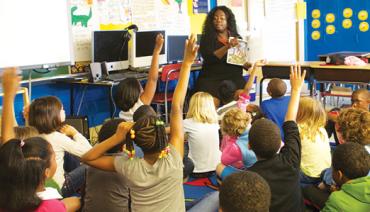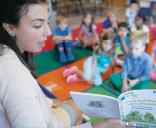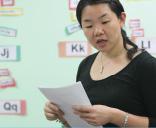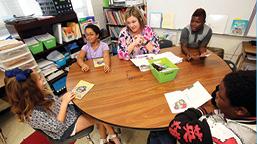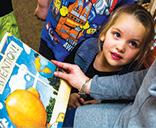How many times have you heard someone say: “In kindergarten through third grade, kids learn to read, and then in fourth grade and beyond, kids read to learn”? This phrase is often used to promote the idea that the early years of schooling should focus primarily on helping children learn to decode text fluently. Fluent decoding is, of course, critical for independent reading, and we do want children to develop this skill in the early grades of school. However, fluent decoding is necessary but not sufficient for successful reading.1
Successful and engaged readers comprehend, learn from, and enjoy what they read. This requires far more than the ability to look at the symbols on the page and say the words that these symbols represent. Readers need background knowledge and vocabulary, they need to know how texts are constructed and how they are used, they need strategies to coach themselves when reading is challenging, and they need to feel motivated to read.
Luckily, children can begin to learn all of this in the early grades of school—by reading! How can children “read to learn” when they are still learning to decode text independently? The answer is that adults read aloud to them. Interactive read-alouds, where adults read text to children and facilitate discussion of the text, are an incredibly effective method for supporting children’s literacy learning. In this article, I describe some of the knowledge and skills that children must develop in order to become successful readers, and I share evidence that read-alouds can support students in this learning. In other words, interactive read-alouds have the power to help children read to learn as they learn to read.
Interactive Read-Alouds
What can children in the early childhood and elementary years learn during interactive read-aloud experiences? It turns out that the answer is a lot. In particular, studies demonstrate that certain ways of reading aloud optimize children’s learning. The read-alouds described below share several key features for supporting student learning. First, most effective instructional practices for read-alouds are interactive. This means that the teacher and students are actively involved in thinking and talking about the read-aloud text. This extra-textual talk (i.e., the talk that happens around the text) facilitates children’s literacy development in both early childhood and the elementary grades.2
Second, most effective read-aloud techniques are purposeful and planned. This means that the teacher has carefully selected the text and determined how it will be used to support student learning. This includes planning how and when the text will be read, what the teacher will explain or model for the students, and the types of questions, ideas, and words that will be discussed. Third, effective interactive read-alouds can and should occur across the school day, in a broad range of content areas, and not just during language arts.
Despite all the evidence that interactive read-alouds support student learning, studies show they may be neglected during instruction in pre-K and elementary classrooms. In our study of 55 kindergarten classrooms,3 we observed instruction for more than 600 hours and found that kindergarten teachers spent, on average, only 8.36 minutes engaged in read-alouds of literature and 1.7 minutes on read-alouds of informational text. Note that an average of 1.7 minutes means that most teachers did not read any informational text at all. Even when texts are read aloud, researchers have documented a focus on fiction texts,4 with limited attention to a broad range of text genres and text structures. Also, the quality of interactive read-alouds may vary greatly across classrooms.5
Learning about the World
Interactive read-alouds provide critical opportunities to support children in building knowledge about the world, and this knowledge can in turn support students’ comprehension of new texts. The more related knowledge students bring to a text, the better they are at comprehending that text.6 Importantly, this idea extends beyond fact-based knowledge and includes broader types of knowledge. For example, studies demonstrate that students have stronger comprehension of texts that align with their cultural knowledge.7
You can test the relationship between knowledge and comprehension by reading the following paragraphs on a topic that you may know little about:
It also meant that black holes had a temperature and had entropy. In thermodynamics, entropy is a measure of wasted heat. But it is also a measure of the amount of information—the number of bits—needed to describe what is in a black hole. Curiously, the number of bits is proportional to the black hole’s surface area, not its volume, meaning that the amount of information you could stuff into a black hole is limited by its area, not, as one might think, its volume.
That result has become a litmus test for string theory and other pretenders to a theory of quantum gravity. It has also led to speculations that we live in a holographic universe, in which three-dimensional space is some kind of illusion.
This text is from the recent New York Times obituary of Stephen Hawking.8 While you may be able to decode the text quite fluently, even for strong readers it can be difficult to really understand what the text is about unless you have some knowledge of theoretical physics. However, for a reader who knows about black holes or string theory, this passage is easy to comprehend.
So, what might the instructional implications of this finding be? First, and most importantly, we can’t wait for children to decode fluently in order to build their knowledge of the world. The goal should be to build children’s knowledge, across a broad range of domains, during the early years of schooling, while they are building their reading fluency. One way to build children’s knowledge is by reading aloud to them. While we need knowledge to understand what we read, it is also the case that the more we read, the more we know. In turn, the more we know, the better we become at reading. So, we should start early by reading aloud to young children from a range of texts and genres to build their knowledge of the world.
Studies have shown benefits for students’ learning when read-alouds are integrated into content-area instruction. For example, several effective programs have integrated read-alouds into science and social studies instruction.9 In particular, read-alouds can provide opportunities for children to learn about and discuss ideas aligned with content-area standards that they cannot experience directly in their classrooms. Whether this is a historical event or the opportunity for a child in a midwestern state to learn about the ocean, read-alouds can bring new ideas into the classroom to support content-area learning goals.
Recently, researchers have shown that reading sets of texts that are conceptually or thematically related can be particularly beneficial for building knowledge.10 The idea is that as knowledge is built over time, students can understand more and more challenging texts. Many adults have had this experience, for example, when taking a class on a new topic or when trying to do research to learn something new. At first, the readings feel incredibly challenging, but over time, the more you read, the clearer the ideas in the texts become. If you read six texts on black holes and cosmology, your understandings of this topic would grow and develop with each text, making it easier and easier to comprehend and learn from the passage you read above. Therefore, teachers should purposefully select sets of related texts with the goal of building children’s knowledge across a series of interactive read-aloud experiences.
As discussed above, reading texts that align with students’ cultural knowledge may support reading comprehension. Therefore, teachers can build upon the funds of knowledge11 that students bring to school by including interactive read-alouds with themes and characters from a broad range of cultures and backgrounds. Reading and discussing culturally diverse texts also aligns strongly with recommendations for enacting culturally relevant literacy instruction in early childhood and elementary classrooms.12
Learning New Vocabulary
Knowing the meaning of words in a text is critical for understanding what we read.13 While we need vocabulary to comprehend what we read, vocabulary can also be built as readers are exposed to challenging new words in text. Evidence from research studies demonstrates that young children learn vocabulary through interactive read-aloud experiences.14
The challenge for our youngest learners, who are not yet able to decode text independently, is that access to the vocabulary of text requires an intermediary—someone to read the text to the child. Unfortunately, if many teachers are not reading aloud regularly to young children, as is indicated by the studies described above, young children may have limited opportunities in school to learn the academic vocabulary of texts. Importantly, as children begin to read independently, they continue to benefit from read-alouds. This is because the texts that beginning readers use for practice purposefully limit challenging vocabulary to make the texts easier to decode. Therefore, while students are learning to decode fluently, teachers can promote vocabulary development by reading aloud from texts that are more challenging than the texts that students can read by themselves.
Children may learn some new vocabulary just from listening to text, but they learn and retain more words when teachers provide child-friendly explanations of new vocabulary.15 For example, after reading the word dreadful, the teacher can stop and say, “When someone feels dreadful, it means she feels awful, she feels very bad.” Studies demonstrate that this practice alone can support children’s word learning, with estimates that children learn about 22 percent of new vocabulary from this type of brief, one-time explanation.16
Interestingly, in this study, two additional explanations of each word’s meaning doubled children’s retention of new words. Child-friendly explanations are not limited to talk about word meanings, but may include a picture, prop, or action (e.g., using an action to explain the word crouch).17 It can be particularly challenging to come up with child-friendly explanations without preparation. So, this practice is more effective when teachers select words to teach and plan these explanations before the read-aloud. Explaining word meanings before or during read-alouds supports vocabulary development, but it also supports children’s comprehension of the text being read.18
Another critical feature of effective vocabulary-focused read-alouds is the opportunity for children to engage in active processing of new words.19 Rather than just passive listening, children need opportunities to discuss the meaning of a new word, act out the meaning, think of synonyms and antonyms, and use the new word in discussion. Typically, this additional practice with words occurs for a small set of important words that the teacher has selected because these are words that children need for future reading (i.e., new or challenging words that occur frequently in text) or for content-area learning.
Providing opportunities for active processing directly after the read-aloud supports students in learning more new vocabulary, but additional practice beyond the initial read-aloud, in other contexts or during a rereading, may be necessary to support retention of new vocabulary.20 The goal is to create engaging opportunities for children to think about and use new words in meaningful ways.
One way to provide repeated exposure to new vocabulary, and to provide opportunities for students to use new words in discussion, is to read multiple texts on the same topic. Typically, books on the same topic include similar words. When listening to and discussing a set of books about birds, for example, students are likely to encounter words like nesting, migrate, and molt multiple times across the texts. Studies have found that this natural repetition in meaningful contexts benefits word learning.21 Therefore, the use of text sets may be particularly beneficial because it supports students in building knowledge and vocabulary simultaneously.
Learning about Text
Good readers know a lot about text and how text functions. In the early childhood years, children need to learn basic concepts about print—for example, that in English, we read print from left to right across a line of text and from top to bottom on a page. Children begin to learn that the writing in text represents oral language—for example, that one word the reader says aloud is represented by one word on the page (often called one-to-one correspondence). Children also need to understand the difference between a letter and a word, and that letters represent particular sounds.
One way that children learn this information is when adults show them how print works during read-alouds. Researchers have tested a method called print referencing, in which the teacher holds the text so that it faces the children.22 The teacher both shows and tells children how text works during the read-aloud. For example, when the teacher runs a finger under the words that are read, children learn about directionality, and when the teacher stops to ask children to notice or point to words, the teacher supports children in developing an understanding of one-to-one correspondence. Studies of print referencing demonstrate that young children make substantial gains in print knowledge when their teachers use this method, compared with children who do not experience this type of interactive read-aloud.23
As children learn to become independent readers and writers, they need more sophisticated understandings about the use and function of texts. There is evidence that developing an understanding of the different purposes for text (e.g., to inform, to persuade, to entertain), and the text genres and structures that align with these purposes, supports students both as readers and as writers.24 Read-alouds provide an important opportunity to expose young children to a range of texts and an opportunity to discuss how authors achieve their purposes for writing. For example, an author who is trying to write an informational text to explain the idea of forces may use a range of text structures to achieve that goal, such as comparing and contrasting pushes and pulls or using cause and effect to show that if you kick a ball, the force will cause it to move. Unfortunately, as discussed above, observational studies demonstrate that read-alouds in the early childhood and elementary grades typically focus primarily on fictional stories, and therefore young children may have few opportunities to develop these understandings across a range of text genres.
Interactive read-alouds that focus on how texts work can also support children as writers. For example, read-aloud texts can be used to help students identify particular features of strong writing.25 One way to do this is by reading aloud a high-quality exemplar of a particular type of text (sometimes called a mentor text) and supporting students in analyzing and discussing features of the text that make it a strong example of writing for that particular purpose. This might include text structures, word choice, use of dialogue, or graphical elements. Students can then use the list of features they have generated as a guide when they engage in their own independent writing.
Learning Literacy Skills and Strategies
Read-alouds also provide the opportunity to teach students a broad range of skills and strategies they will need as they become independent readers. In the early childhood years, young children need to develop phonological awareness (i.e., the ability to distinguish sounds in oral language), letter recognition, and knowledge of letter-sound relationships. (For more on effective literacy instruction in early childhood, see the articles "First Steps Toward Literacy" and "Phonics Faux Pas.") These foundational skills can be supported through read-alouds. Children build phonological awareness through interactive read-alouds of books that play with language, such as books that include rhyme or alliteration. Alphabet books promote letter recognition and support students in associating letters with key words that represent particular sounds that letters make. Making these read-alouds interactive by encouraging children’s participation (“What pictures do you see that start with the /b/ sound?”) can support their development of these early literacy skills.
Teachers can also engage in read-alouds to model reading strategies, intentional mental actions that children can use to coach themselves through reading or writing tasks.26 Researchers argue that reading strategies are best taught through a gradual release of responsibility framework.27 The early stages of this framework suggest that teachers model strategy use before students use the strategy with guidance and independently. During interactive read-alouds, teachers can model the use of a broad range of strategies. These may include comprehension strategies (e.g., monitoring, visualizing, or asking questions) or decoding strategies (e.g., saying the sounds in the word or trying a different vowel sound). Beyond just showing children how to use reading strategies, interactive read-alouds enable teachers and children to take time to discuss why and when a particular reading strategy may be most effective.
Interactive read-alouds provide important opportunities to support students to think deeply about and discuss the meaning of texts.28 In particular, teachers can use text-based discussion to help students move beyond literal comprehension of a text in order to focus on applying the ideas that were learned. While it is important to make sure that students understand what is happening in the text as it is read, there is growing evidence that young students are capable of higher-order discussion to support deeper comprehension of text.29 Young children need opportunities to apply ideas, to compare and contrast different parts of a text or multiple texts, to determine the author’s purpose and to consider whether the text accomplishes this purpose, and to take a stand on an argument presented in a text. Studies, beginning in the early childhood years, demonstrate that when teachers engage children in more analytic talk during read-alouds, this has long-term benefits for their vocabulary development and text comprehension.30
Several groups of researchers have studied methods for supporting discussion during the early childhood and elementary years of school.31 Included as recommendations in all of these studies is the idea that teachers should promote discussion by asking open-ended questions (e.g., how and why questions) and by supporting children to understand and analyze the decontextualized language in texts (i.e., language that is used to convey ideas that are beyond the immediate context). Text-based discussions with younger students may require other scaffolds to prompt conversation, such as providing students with sentence starters that they can use to discuss the text (e.g., “I agree with you because…”) or giving students opportunities for small-group or partner discussion before discussing the text as a whole group.
Finally, it is important to remember that children love to listen to and participate in interactive read-alouds. I recently visited an early childhood classroom where children had so many favorite books to suggest for read-alouds that the teacher created a “please read” bin where children could place these book requests. Anyone who has spent time in an early childhood or elementary classroom has seen the joy on children’s faces when it is time for the teacher to read aloud. In fact, this is such a favorite time of day that researchers have recommended that extra teacher read-aloud time may be an appropriate reward to encourage children’s independent reading.32
Read-alouds enable children who are not yet reading independently to experience the way reading feels to fluent readers—the pleasure of being swept up in a story, the thrill of learning something new. It is important to maintain this sense that reading is joyful, while also providing opportunities for students to learn, during interactive reading experiences.
One way to maintain this balance is to keep the primary focus on meaning. Sometimes when teachers engage in read-alouds, they focus so much on planned learning goals that the meaning of the text can be lost for children. For example, during a print referencing read-aloud, if the teacher spends too much time pointing out letters and words, the children may not be able to follow the story in the text. Or, if the teacher tries to address too many instructional goals during one interactive read-aloud, the session may go on for too long and the children may lose interest. For example, a teacher may attempt to teach print concepts and five new vocabulary words and a summarizing strategy and then lead a text-based discussion during one read-aloud session. If there are multiple teaching goals, it is most useful to read the text through with a focus on meaning and then revisit the text (or parts of the text) at a later time for additional instructional purposes.
Given all that students learn from participating in interactive read-alouds, a common question from teachers is how much time to dedicate to them. Overall, given the variety of opportunities to learn during read-alouds, it may be most beneficial to read to children multiple times per day for different instructional purposes. But, there is really no clear-cut answer to this question.
In consensus documents written by educational stakeholders in Michigan, where I live, we suggest that read-alouds are an “essential instructional practice” for supporting literacy in pre-K and early elementary school classrooms. By this, we mean that children in every classroom should participate in a high-quality interactive read-aloud every day. Given studies that suggest that read-alouds may not be occurring at all in some classrooms, this goal seems like a critical first place to start.
Tanya S. Wright is an associate professor in the Department of Teacher Education at Michigan State University. A former kindergarten teacher, her research and teaching focus on curriculum and instruction in language and literacy in early childhood and elementary school.
Endnotes
1. Marsha Riddle Buly and Sheila W. Valencia, “Below the Bar: Profiles of Students Who Fail State Reading Assessments,” Educational Evaluation and Policy Analysis 24 (2002): 219–239; and Scott G. Paris, “Reinterpreting the Development of Reading Skills,” Reading Research Quarterly 40 (2005): 184–202.
2. See, for example, David K. Dickinson and Miriam W. Smith, “Long-Term Effects of Preschool Teachers’ Book Readings on Low-Income Children’s Vocabulary and Story Comprehension,” Reading Research Quarterly 29 (1994): 105–122; Edna Greene Brabham and Carol Lynch-Brown, “Effects of Teachers’ Reading-Aloud Styles on Vocabulary Acquisition and Comprehension of Students in the Early Elementary Grades,” Journal of Educational Psychology 94 (2002): 465–473; and Maria Varelas and Christine C. Pappas, “Intertextuality in Read-Alouds of Integrated Science-Literacy Units in Urban Primary Classrooms: Opportunities for the Development of Thought and Language,” Cognition and Instruction 24 (2006): 211–259.
3. Tanya S. Wright and Susan B. Neuman, “Paucity and Disparity in Kindergarten Oral Vocabulary Instruction,” Journal of Literacy Research 46 (2014): 330–357; and Tanya S. Wright, “From Potential to Reality: Content‐Rich Vocabulary and Informational Text,” The Reading Teacher 67 (2014): 359–367.
4. Nell K. Duke, “3.6 Minutes per Day: The Scarcity of Informational Texts in First Grade,” Reading Research Quarterly 35 (2000): 202–224; and Jill M. Pentimonti, Tricia A. Zucker, and Laura M. Justice, “What Are Preschool Teachers Reading in Their Classrooms?,” Reading Psychology 32 (2011): 197–236.
5. Laura M. Justice et al., “Quality of Language and Literacy Instruction in Preschool Classrooms Serving At-Risk Pupils,” Early Childhood Research Quarterly 23 (2008): 51–68; Karen J. Kindle, “Same Book, Different Experience: A Comparison of Shared Reading in Preschool Classrooms,” Journal of Language and Literacy Education 7, no. 1 (2011): 13–34; and Susan L. Massey et al., “Educators’ Use of Cognitively Challenging Questions in Economically Disadvantaged Preschool Classroom Contexts,” Early Education and Development 19 (2008): 340–360.
6. For a review on the relationship between knowledge and comprehension, see Gina N. Cervetti and Tanya S. Wright, “The Role of Knowledge in Understanding and Learning from Text,” in Handbook of Reading Research, vol. 5, ed. Elizabeth Moje et al. (New York: Routledge, forthcoming).
7. See, for example, Yvonne R. Bell and Tangela R. Clark, “Culturally Relevant Reading Material as Related to Comprehension and Recall in African American Children,” Journal of Black Psychology 24 (1998): 455–475; and Heather M. Kelley et al., “Culturally Familiar Tasks on Reading Performance and Self-Efficacy of Culturally and Linguistically Diverse Students,” Educational Psychology in Practice 31 (2015): 293–313.
8. Dennis Overbye, “Stephen Hawking Dies at 76; His Mind Roamed the Cosmos,” New York Times, March 15, 2018.
9. See, for example, Cynthia B. Leung, “Preschoolers’ Acquisition of Scientific Vocabulary through Repeated Read-Aloud Events, Retellings, and Hands-On Science Activities,” Reading Psychology 29 (2008): 165–193; Pamela Spycher, “Learning Academic Language through Science in Two Linguistically Diverse Kindergarten Classes,” Elementary School Journal 109 (2009): 359–379; Stephanie L. Strachan, “Kindergarten Students’ Social Studies and Content Literacy Learning from Interactive Read-Alouds,” Journal of Social Studies Research 39 (2015): 207–223; Michael R. Vitale and Nancy R. Romance, “Using In-Depth Science Instruction to Accelerate Student Achievement in Science and Reading Comprehension in Grades 1–2,” International Journal of Science and Mathematics Education 10 (2012): 457–472; and Tanya S. Wright and Amelia Wenk Gotwals, “Supporting Kindergartners’ Science Talk in the Context of an Integrated Science and Disciplinary Literacy Curriculum,” Elementary School Journal 117 (2017): 513–537.
10. See, for example, Gina N. Cervetti, Tanya S. Wright, and HyeJin Hwang, “Conceptual Coherence, Comprehension, and Vocabulary Acquisition: A Knowledge Effect?,” Reading and Writing 29 (2016): 761–779; Tanya S. Wright and Gina N. Cervetti, “Supporting Vocabulary Acquisition and Comprehension with Conceptually-Coherent Text Sets” (poster presentation, 24th Annual Meeting Society for the Scientific Study of Reading, Halifax, NS, July 12, 2017); and Susan B. Neuman, Tanya Kaefer, and Ashley M. Pinkham, “Improving Low-Income Preschoolers’ Word and World Knowledge: The Effects of Content-Rich Instruction,” Elementary School Journal 116 (2016): 652–674.
11. Luis C. Moll et al., “Funds of Knowledge for Teaching: Using a Qualitative Approach to Connect Homes and Classrooms,” Theory Into Practice 31 (1992): 132–141.
12. Gloria Ladson-Billings, “Culturally Relevant Pedagogy 2.0: a.k.a. the Remix,” Harvard Educational Review 84 (2014): 74–84; Kristan A. Morrison, Holly H. Robbins, and Dana Gregory Rose, “Operationalizing Culturally Relevant Pedagogy: A Synthesis of Classroom-Based Research,” Equity & Excellence in Education 41 (2008): 433–452; and Mariana Souto-Manning, Multicultural Teaching in the Early Childhood Classroom: Strategies, Tools, and Approaches, Preschool–2nd Grade (New York: Teachers College Press, 2013).
13. For a review of this research, see Tanya S. Wright and Gina N. Cervetti, “A Systematic Review of the Research on Vocabulary Instruction That Impacts Text Comprehension,” Reading Research Quarterly 52 (2017): 203–226.
14. See Loren M. Marulis and Susan B. Neuman, “The Effects of Vocabulary Intervention on Young Children’s Word Learning: A Meta-Analysis,” Review of Educational Research 80 (2010): 300–335; Suzanne E. Mol, Adriana G. Bus, and Maria T. de Jong, “Interactive Book Reading in Early Education: A Tool to Stimulate Print Knowledge as Well as Oral Language,” Review of Educational Research 79 (2009): 979–1007; and Barbara A. Wasik, Annemarie H. Hindman, and Emily K. Snell, “Book Reading and Vocabulary Development: A Systematic Review,” Early Childhood Research Quarterly 37 (2016): 39–57.
15. Andrew Biemiller and Catherine Boote, “An Effective Method for Building Meaning Vocabulary in Primary Grades,” Journal of Educational Psychology 98 (2006): 44–62; and Isabel L. Beck and Margaret G. McKeown, “Increasing Young Low‐Income Children’s Oral Vocabulary Repertoires through Rich and Focused Instruction,” Elementary School Journal 107 (2007): 251–271.
16. Biemiller and Boote, “An Effective Method.”
17. Barbara A. Wasik and Mary Alice Bond, “Beyond the Pages of a Book: Interactive Book Reading and Language Development in Preschool Classrooms,” Journal of Educational Psychology 93 (2001): 243–250.
18. Wright and Cervetti, “A Systematic Review.”
19. Isabel L. Beck and Margaret G. McKeown, “Conditions of Vocabulary Acquisition,” in Handbook of Reading Research, vol. 2, ed. Rebecca Barr et al. (Mahwah, NJ: Lawrence Erlbaum Associates, 1991), 789–814; and Margaret G. McKeown and Isabel L. Beck, “Effects of Vocabulary Instruction on Measures of Language Processing: Comparing Two Approaches,” Early Childhood Research Quarterly 29 (2014): 520–530.
20. Michael D. Coyne, D. Betsy McCoach, and Sharon Kapp, “Vocabulary Intervention for Kindergarten Students: Comparing Extended Instruction to Embedded Instruction and Incidental Exposure,” Learning Disability Quarterly 30 (2007): 74–88; Marulis and Neuman, “The Effects of Vocabulary Intervention”; and Susan B. Neuman and Tanya S. Wright, “The Magic of Words: Teaching Vocabulary in the Early Childhood Classroom,” American Educator 38, no. 2 (Summer 2014): 4–13.
21. See, for example, Cervetti, Wright, and Hwang, “Conceptual Coherence”; Wright and Cervetti, “Supporting Vocabulary Acquisition”; Jorge E. Gonzalez et al., “Developing Low-Income Preschoolers’ Social Studies and Science Vocabulary Knowledge through Content-Focused Shared Book Reading,” Journal of Research on Educational Effectiveness 4 (2010): 25–52; and Susan B. Neuman, Ellen H. Newman, and Julie Dwyer, “Educational Effects of a Vocabulary Intervention on Preschoolers’ Word Knowledge and Conceptual Development: A Cluster‐Randomized Trial,” Reading Research Quarterly 46 (2011): 249–272.
22. Tricia A. Zucker, Allison E. Ward, and Laura M. Justice, “Print Referencing during Read‐Alouds: A Technique for Increasing Emergent Readers’ Print Knowledge,” The Reading Teacher 63 (2009): 62–72.
23. See, for example, Laura M. Justice and Helen K. Ezell, “Use of Storybook Reading to Increase Print Awareness in At-Risk Children,” American Journal of Speech-Language Pathology 11 (2002): 17–29.
24. Steve Graham et al., Teaching Elementary School Students to Be Effective Writers: A Practice Guide, NCEE 2012-4058 (Washington, DC: U.S. Department of Education, 2012); and Timothy Shanahan et al., Improving Reading Comprehension in Kindergarten through 3rd Grade: A Practice Guide, NCEE 2010-4038 (Washington, DC: U.S. Department of Education, 2010).
25. Graham et al., Teaching Elementary School Students.
26. Peter Afflerbach, P. David Pearson, and Scott G. Paris, “Clarifying Differences between Reading Skills and Reading Strategies,” The Reading Teacher 61 (2008): 364–373.
27. See, for example, Nell K. Duke et al., “Essential Elements of Fostering and Teaching Reading Comprehension,” in What Research Has to Say about Reading Instruction, 4th ed., ed. S. Jay Samuels and Alan E. Farstrup (Newark, DE: International Reading Association, 2011), 51–93.
28. Varelas and Pappas, “Intertextuality in Read-Alouds.”
29. Shanahan et al., Improving Reading Comprehension.
30. Dickinson and Smith, “Long-Term Effects.”
31. See, for example, Isabel L. Beck and Margaret G. McKeown, “Text Talk: Capturing the Benefits of Read-Aloud Experiences for Young Children,” The Reading Teacher 55 (2011): 10–20; Lea M. McGee and Judith A. Schickedanz, “Repeated Interactive Read‐Alouds in Preschool and Kindergarten,” The Reading Teacher 60 (2007): 742–751; and Grover J. Whitehurst et al., “A Picture Book Reading Intervention in Day Care and Home for Children from Low-Income Families,” Developmental Psychology 30 (1994): 679–689.
32. Barbara A. Marinak and Linda B. Gambrell, “Intrinsic Motivation and Rewards: What Sustains Young Children’s Engagement with Text?,” Literacy Research and Instruction 47 (2008): 9–26.

